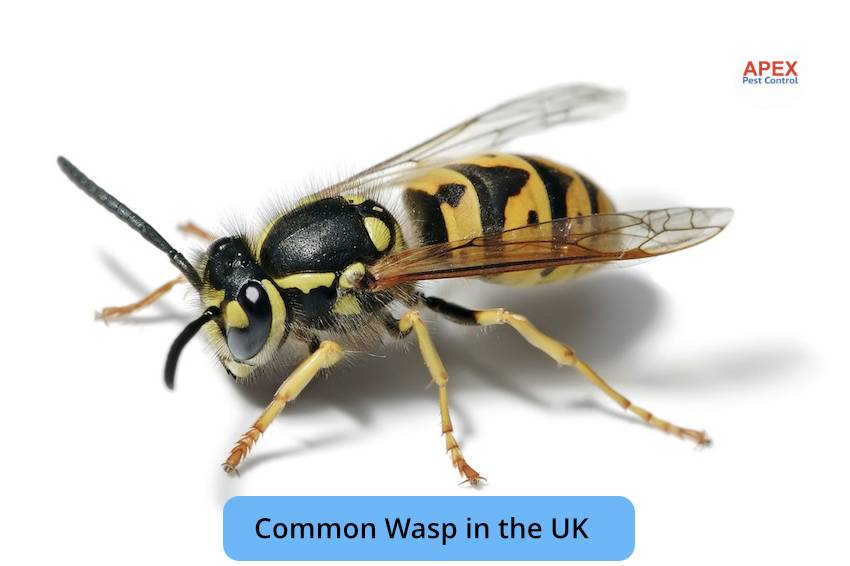Wasp Nest Removal Leeds; How to Identify and Get Rid of Wasps
Wasps usually start appearing in the UK around the beginning of May, depending on the species. There are approximately 9 main types of wasp people see and encounter, and these are the larger wasps which have a stinger.
The queen-wasps begin their work in April, and by June to August, you can witness the peak of wasp’s activity.
To enjoy a wasp-free summer wasp control is considered the most reliable method for getting rid of pesky invaders. However, the critical question is – what is an ideal way of wasp nest removal?
Although the problem is enormous, it is easy to find DIY methods for wasp removal, pest control experts advise totally against it.
At Apex Pest Control Leeds, we give excellent service to home-owners and businesses with easy, safe and timely Leeds wasp nest removal. We help to protect people and their families, leading to clean and safe homes and offices using effective nest treatment.
If you are looking for professional pest control and wasp nest removal Leeds, give us a call on 0113 3904270
Types of Wasps
The first step to discovering a wasp pest problem in your home is to identify the insect correctly. Having a good understanding of the characteristics of wasp’s will let you tell them apart from bees.
Wasp is a blanket term used for a bunch of species, including the hornet. There are more than 100,000 wasp species on Earth and over 9,000 in the UK alone.
Below are the main 4 types of wasp’s you should be cautious of since the queen wasps are known to build nests in any buildings wall voids and roof spaces.
YellowJackets
One of the most distinctive features of YellowJackets is the thick black antennae. However, their distinct features include long wings, the size of their body, i.e., approximately 10-16mm and are shiny. Moreover, they are black and yellow and are not hairy.
These types of wasps are known for the queen wasp to build her nest site and colony in enclosed spaces, including wall voids and hollow space in the ground. They are often referred to as social wasp’s and are known for their aggressive behaviour as they can sting multiple times.
Paper Wasps
Paper wasps are identified by the size of the body, which is relatively large – about ½ to 1 inch and have black and brown coloured bodies. They have yellow markings on their bodies, and the colour of their wings is grey.
They attack when they feel threatened, which is another reason we advise leaving the wasp removal process to a professional pest expert.
Hornets
Mature Hornets are typically larger than YellowJackets, and their length is approximately ¾ inch. Generally, Hornets get seen in light yellow or white and black.
Hornets are common UK bug that gets found building a colony in the wall cavities as well as the tree trunk. Hornets are known to hunt other insects and aren’t aggressive unless threatened.
Common and German Wasps

Common and German wasps are customary in the UK and get found to be in black and yellow colour. They measure 12-17mm. These two types of species can build their nests inside your home as well as outside in the garden.
You can spot their nests in rodent burrows, trees and bushes, attic, and garage.
Both of these species possess a single queen who can produce up to 6,000 – 10,000 worker wasps. Their sting is quite painful, akin to other wasp’s and they have a bad temperament.
Is Wasp Stings Dangerous?
Wasp’s can be quite dangerous. However, you should note that wasp’s generally minded their own business unless threatened.
Once threatened, wasp’s can grow aggressive and sting multiple times.
Their sting contains venom, and since these are territorial insects, they can sting their intruder. When a wasp stings you, it releases a pheromone that alerts other wasps there’s a danger here. Apart from feeling threatened, wasp’s also sting when they get panicked.
If you’re allergic to wasp or any other insect, their sting could have a severe effect on your health. Anaphylaxis is the medical name for allergy to stings which can lead to life-threatening critical reactions such as difficulty breathing, severe swelling, shock and skin rash.
Even if you are not allergic, you can get stung by the flying insects. A sting causes redness and irritation.
3 Signs You Have a Wasp Nest
One of the most common signs of having a wasp nest at home is the increased activity of worker wasp’s in your garden. Seeing a high number of wasp’s does not make it sure if you have a nest since their colony could be in a nearby garden.
The three signs to look out for:
A Constant Buzzing Sound
If you continuously hear buzzing sound either inside of your home or in the garden, there could be a wasp nest nearby. This is because as wasp’s start building their home, they produce an unmistakable buzzing sound which is an indication of a wasp nest.
A Swarm of Wasps
Another clear indication of an infestation is a rise in the wasp activity of the worker wasps or swarms and a continuous returning wasp.
However, the mere presence of wasp’s does not necessarily mean there’s a nest since they could be in the nearby localities as well.
One interesting fact about wasps is that they do not have a strong vision. They leave behind trails to follow back to their nest. Hence, they have the same route to and fro to their home.
Evident Structures
Wasp nests are thin-papery material that can get spotted in various points. It is worth noting that the insects will build their nests nearby the old site, giving an impression of accommodating the more former wasp nest.
Familiar Places for Wasps Nests
Wasps will build a nest anywhere there is food and building materials. The wasps also like the sun, so south-facing properties are a perfect location.
Nonetheless, to simplify your search, here are the top 8 places for you to locate a wasp nest.
- Tree trunk or bushes
- Garage
- Dog kennels
- Garden sheds
- Log storage
- Wall cavities
- Attic, eaves, or roof of the home
- Under the soil in the garden
How Big Are Wasp Nests?
A wasps nest could be the size of a golf ball initially, and this is up to May.
Eventually, it grows to become the size of a rugby ball by June-July. Afterwards, it can grow even more prominent, and the average nest holds between 300-6000 individuals in the height of summer.
How much does it cost to remove a wasp nest?
Wasp nest removal costs vary between different pest companies across Leeds as they may use different control methods. Typically a trained and experienced nest removal or pest exterminator will charge a fixed price from £55 to £65 for a straightforward problem including a call-out charge. However, for awkward and hard to reach nests, the price will be more for effective wasp control.
At Apex, wasp nest removal problems get solved quickly and safely with just one phone call. If you want wasp removal and looking for quality, great service and wasp nest removal Leeds, our pest controllers charges from £65.
Wasp Nest Removal Service in Leeds, UK.
At Apex Pest Control Leeds, we have a professionally trained team of wasp removal experts. Each pest controller is certified and ready to handle your wasp issue even in the most hard-to-reach spots. Each pest controller uses all the professional equipment, gear and knowledge and will handle the problem situation with complete service and care.
We provide our services in the wasp nest removal to residential and commercial properties. We keep our wasp nest removal costs low and help you get rid wasps nest safely while protecting your property.
For Leeds pest control, our friendly nest removal team will arrive at your doorsteps at a time convenient for you.
Contact us today for effective wasp nest removal Leeds, Call us on 0113 3904270 and leave the rest to us!
Read our related post on bed bugs

Tony Johnson, Founder & Lead Technician at Apex Pest Control, is a BPCA and NPTA accredited pest management expert with over 35 years’ hands-on experience. Tony specialises in Integrated Pest Management and ensures all services comply with UK pest legislation, including the Wildlife and Countryside Act 1981 and COSHH Regulations 2002. His commitment to continual learning and adapting to industry best practices means clients receive effective, safe solutions for pests affecting homes and businesses across South Yorkshire. Tony’s dedication to professional standards, ethical treatment methods, and local expertise has made him a trusted partner for pest control and prevention.
-
BPCA & NPTA accredited | CHAS certified
-
Committed to UK pest law compliance & safety
-
Focused on effective, ethical pest management for South Yorkshire


